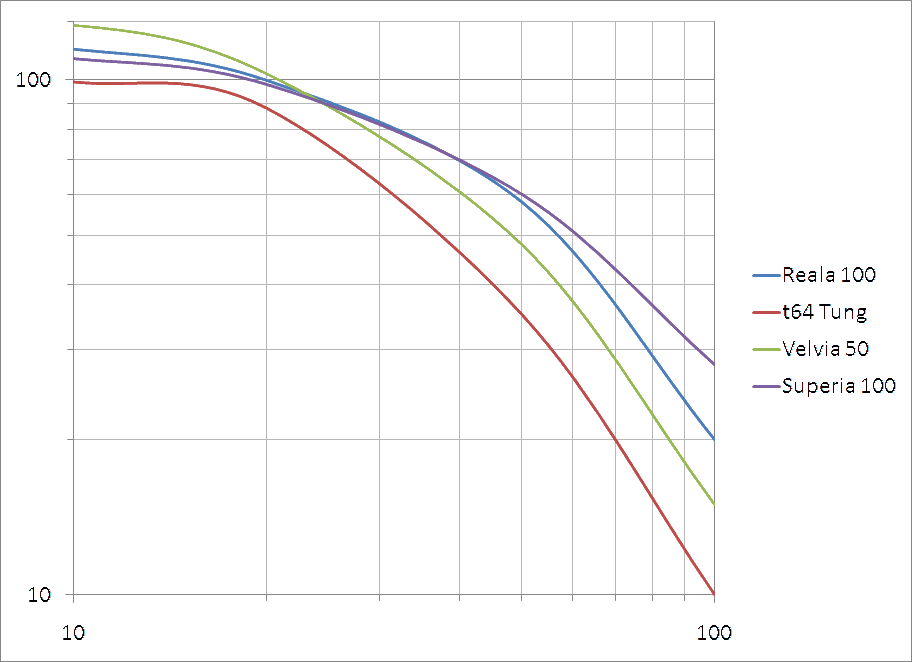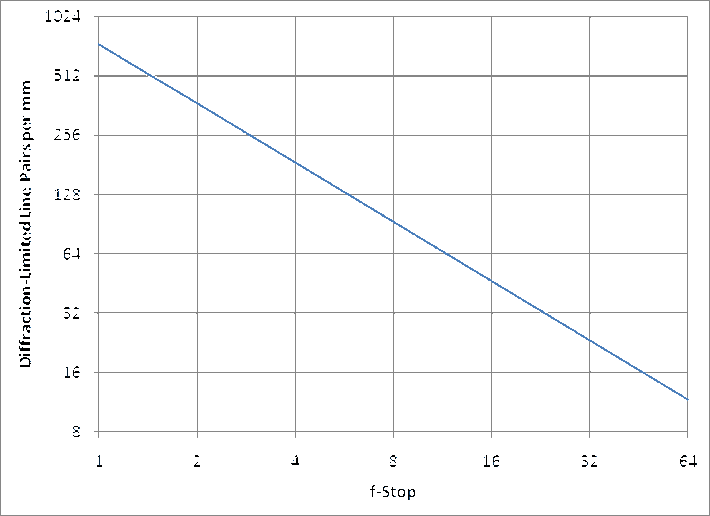Navigation
- Disclaimer
- Variable Names used on this page
- What are the relationships between line pairs per mm and image size in megapixels?
- What are the resolutions of 35mm films?
- How many lines per mm do I really get on the film plane?
- What about the optics?
- What do I achieve on the image, taking both film and optics into account?
- Comment on this article
Disclaimer
I have not yet determined the resolution of some of the excellent films currently available from Kodak, Fuji and others. The analysis done here is based on experience and data available from data sheets available online as of December 2010. Please check the Film Photography Resources Page for information about some of the high resolution films available today.
Variable Names Used Here
| Symbol | Description | Units |
|---|---|---|
| X,Y | Image plane horizontal and vertical dimensions | Millimeters |
| AspectR | Ratio of X size to Y size, presumed larger than 1 | Number |
| NY | Number of pixels in Y direction | Number |
| LPmm | Number of line pairs per millimeter | 1/mm |
| MPX | Number of megapixels | Number |
| D | Aperture width | Millimeters |
| λ | Wavelength of light; green is 550 nanometers | Millimeters |
| f | Focal length of lens | Millimeters |
| θA | Angular resolution of lens according to Airy disk | Radians |
| SDIST | Distance to the subject from the camera | Meters |
| IPpitch | Image plane distance between pixels | μm |
Film and Megapixels
A Common Ground: Number of pixels in the vertical direction
How many megapixels are in a film image? This is an important question for comparison of quality between film cameras and digital cameras and raises itself in the choice of resolution in digitizing negatives and slides.
The answer is not an exact thing, for many reasons, including, but not limited to, the following:
- 35mm full frame images of 24mm by 36mm have an aspect ratio, which we will call AspectR, of 1.5:1 or 3:2, while some digital cameras – notably the four-thirds system – use an AspectR of 4:3, or 1.33. See the graphic on the Canon FL and FD optics for a look at most common image plane sizes.
- The most common print sizes have aspect ratios near 5:4, or 1.20.
- Film resolution varies between film types, and the image that the camera records on a particular film varies with exposure and other factors.
- The image that the camera records on the image plane is often a complex interaction of focus accuracy, depth of field, subject motion, and camera motion, particularly in action and sports photography.
- The lens image sharpness can limit resolution, particularly at the edges and corners, and very fast lenses within a stop or two of full aperture.
In order to eliminate aspect ratio so that we are talking about the same number for different cameras, different image plane sizes, and different print sizes and aspect ratios, I will present results in terms of the number of pixels across the image in the smallest direction. For example, for an image of 5616 by 3744, this number is the smaller of the two, 3744. We will call this number NY, the number of pixels in the Y direction, or vertically; we presume a landscape orientation for this purpose.
As an exercise for the reader, I will leave it to you to show the following relationships:
What are the resolutions of 35mm films?
Browse the enthusiast literature or the web and you will find many claims, some seemingly very credible, about the resolution capabilities of 35mm films. Numbers as high as 200 lines per mm can be seen if you look for them; these may be double what we are calling line pairs per mm, but even so this is a high figure, particularly for color film. The truth is a bit unsettling. I've looked at Fuji Film data sheets as of November 2010 and found their plots of image contrast versus line pairs (or cycles, in their data sheet) per millimeter, estimated values from them and entered them in a spreadsheet. I then plotted the curves to approximate the curves given in the Fuji data sheets. For their ISO 50 and 100 films, the result is here:

Data sheets of others such as Kodak and Agfa are similar. Slower films are better than faster films because high ISO films have thicker emulsions to capture more of the light, which is why the slowest films are shown here, and why Ektar 25 was sold for a time. The truth of the matter is that none of the color films exceeds about 65 line pairs per millimeter. Kodachrome, while it lasts, is a little better because the emulsion is thinner than that of any E6 or C41 process film.
I don't have access to similar data for B/W films but will plot that data when I have it. My estimate is that the best of these films (special copy or process films, Kodak Panatomic X and other low ISO fine grain films) will achieve up to about 100 line pairs per millimeter at best.
Lines per Millimeter on the Film Plane
Using the equations given above with 65 lines per millimeter, this gives us 3120 for NY, or about 13 megapixels for a 4:3 aspect ratio or 14.6 megapixels for a 3:2 aspect ratio.
Using a more realistic 50 line pairs per millimeter, we have a value of 2400 for NY, or about 7.68 megapixels for a 4:3 aspect ratio or 8.64 megapixels for a 3:2 aspect ratio.
The camera magazines once tested and printed actual resolutions for film as measured in their laboratories. I recall a figure of 40 line pairs per millimeter for a very popular slide film, Kodak High Speed Ektachrome Daylight, ISO 160. For this resolution, NY is 1920, and image resolutions are 4.9 and 5.5 megapixels.
So, we have anywhere from about 5 megapixels to an ultimate maximum of about 15 megapixels as the range of effective image resolutions for 35mm film. And, you can scan your slides and negatives at 2000 DPI to 3000 DPI and get all there is on the image. Going farther and resolving the grain may be psychologically better but you won't get better prints from the files, and processing them to print well may be more difficult. It may be better to let the scanner optics and software do the averaging than to struggle with it yourself in the post-processing software.
What About the Optics?
The resolution of an lens in terms of angle is usually given in terms of the peak-to-null distance of the Airy disk, the diffraction-limited focus point of a circular disk. This is, in terms of the subtended angle from the lens,
This is an enormously important equation because it tells us the resolution of the optics out in the world. If the distance to the subject is R, the resolvable distance on the subject SD is
These two simple equations tell you the resolvable elements — the pixels — on the subject! Wait — you really need to have your information in terms of the f-stop and the distance? Well, the f-stop is
and the wavelengths of visible light range from 0.4 μm to 0.7 μm, with the center of this range being green light with a wavelength of 0.55 μm, so we have the angular resolution in the world, for green light, as
To get the distance between the center of resolvable points on the image plane, the pitch or distance between resolvable pixels on the image plane IPPitch, we multiply the angular resolution by the focal length f; thus
in microns (SI unit μm) for green light; a micron is 10-6 meters, or 1/1000 millimeter. Note we have assumed that the object distance is many focal lengths away from the camera. What we have is the minimum resolvable distance on the image plane is proportional to the f-stop and the wavelength.
Since the optical limit of resolution on the image plane is independent of the focal length, this means that the ultimate number of resolvable pixels attainable is proportional to the area of the focal plane. Note that the number of pixels in the Y direction is limited, unless we want to oversample a diffraction-limited image, by
We have enough to show the diffraction limitations on lines per millimeter on the focal plane versus the f-stop:

Note that this curve is idealized and that essentially no lenses achieve diffraction limited performance with apertures faster than about f/4. The range is about f/2.8 for very expensive lenses and only at the center of the field, to a more typical f/8 or smaller for affordable lenses. This curve also tells us why lenses for digital cameras are more expensive than the old film camera lenses, why point-and-shoot cameras with small focal planes don't stop down below f/8, and why professionals never go below f/11 even with macrophotography when good sharpness is mandatory.
Taking Both Film and Optics Into Account
This is really very simple.
- Use a maximum of what the film will provide, which is 40 to 65 line pairs per mm for color films, a little more if you will accept a little noise that sharpening filtering brings up but never more than 65 line pairs per mm, for f5.6 and faster apertures.
- For f/11 when the film resolution is about equal to the optical limit, multiply by 0.7 (you get 45 lines per mm for this example!).
- Gracefully go to ether the curve plotted above for smaller apertures and to the film resolution for larger apertures.
- Remember that lenses faster than about f/2.8 usually degrade in sharpness as the aperture increases above f/2.8 even in the center of the image, because full correction of aberrations over large apertures becomes impractical or impossible, particularly for zooms.
- Nearly every lens commercially available degrades in performance away from the center of the image, particularly those with focal lengths shorter than about 80 mm, because full correction of aberrations over large angles off axis becomes impractical or impossible, particularly for zooms.
Bottom line?
- When sharpness or enlargeability is paramount, shoot at f/8.
- If you must have that low-light capability, understand the limitations of the particular lens that you are using.
- If you need to stop down to get extra depth of field, use the curve or equations to know what your image resolution is.
- Don't expect the edges and corners to be as good as the center of the image, particularly for lenses shorter than about 80mm.




![thetaA=.000617*[f-stop]/f](images/ThetaA=.000671XfstopOverf.gif)
![IPPicth=0.671*[f-sto]](images/IPPitch=0.671_f-stop.gif)
